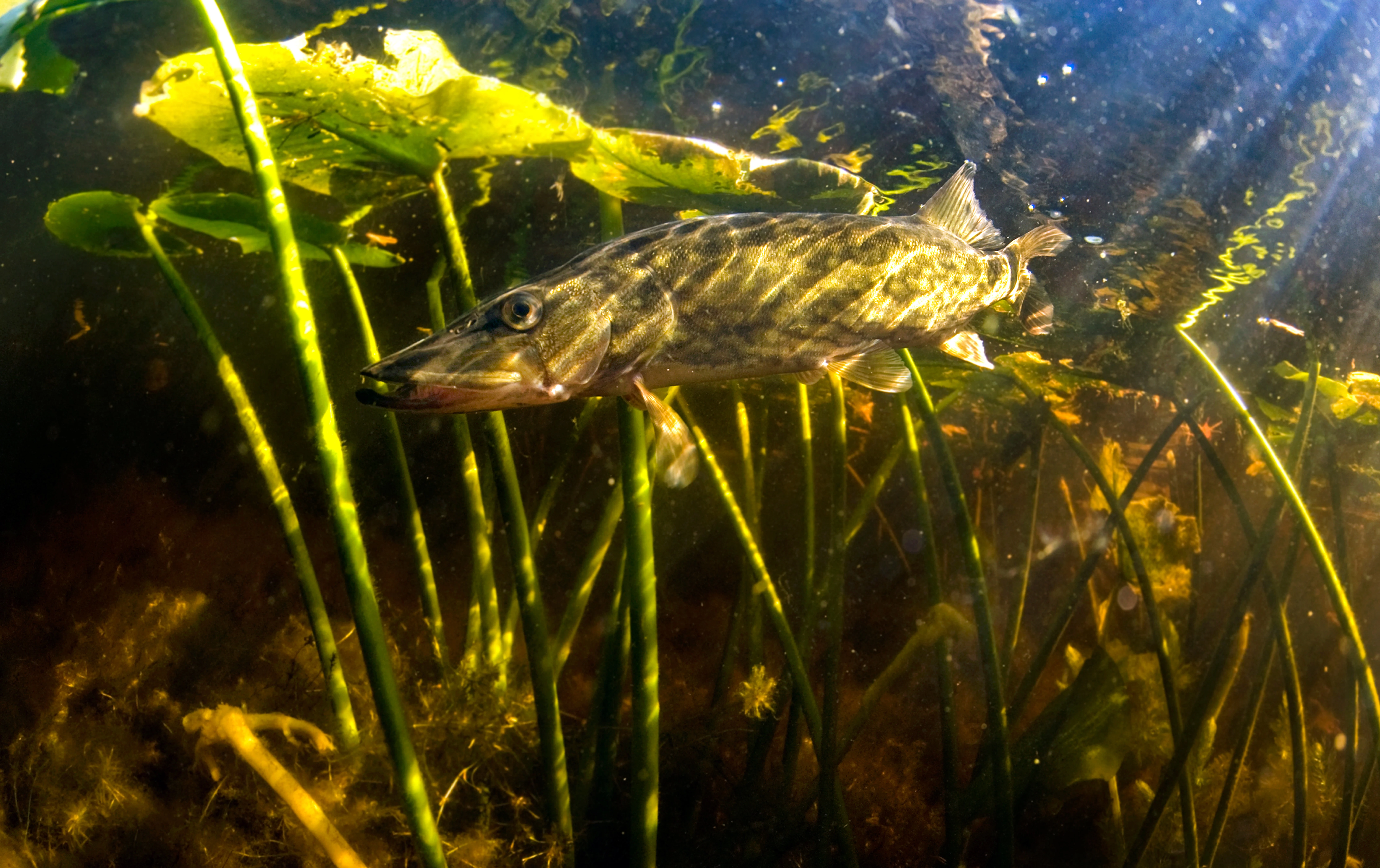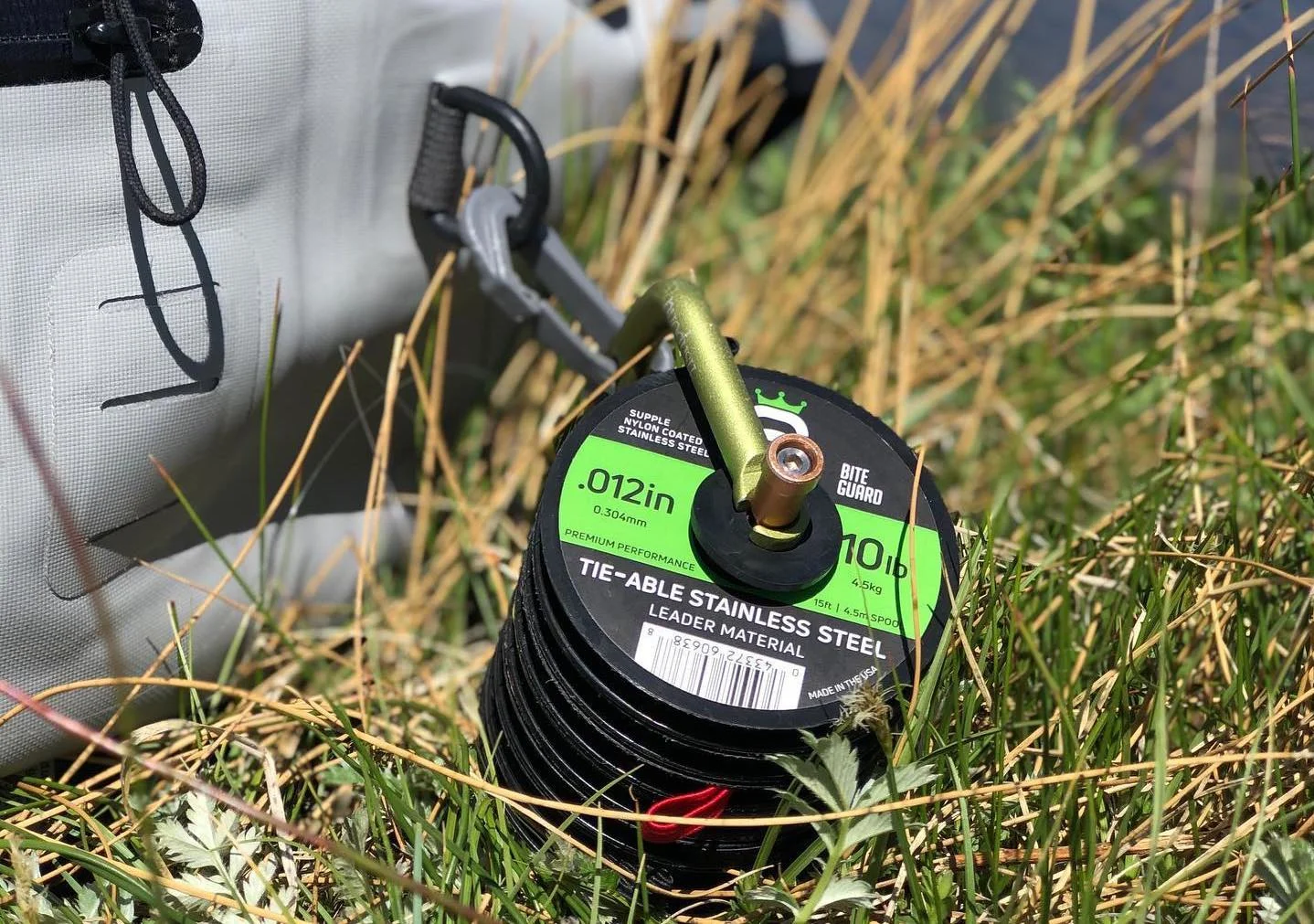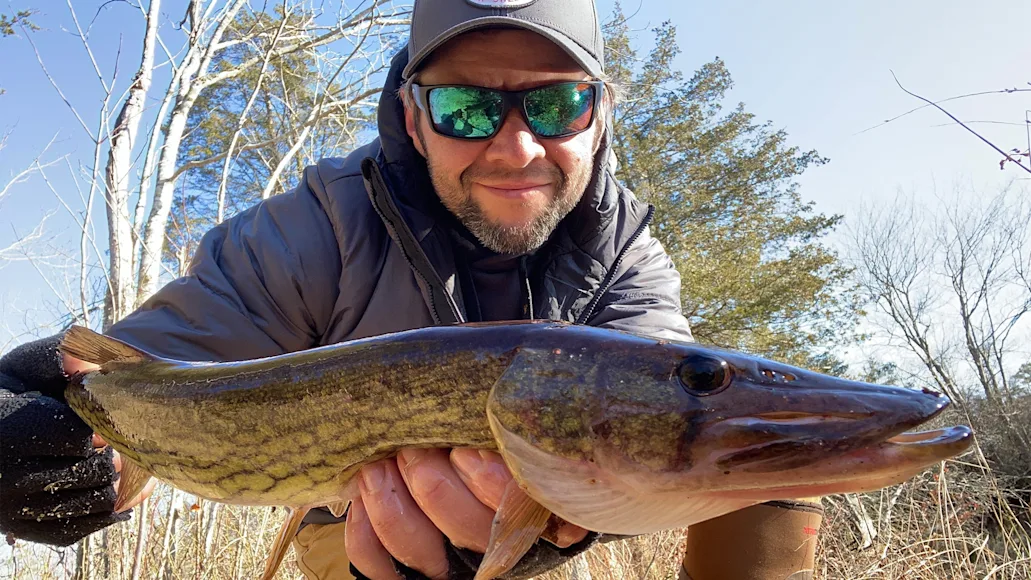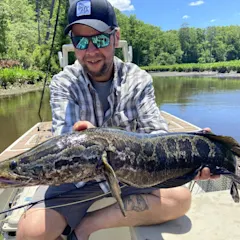_We may earn revenue from the products available on this page and participate in affiliate programs. Learn more ›
_
Chain pickerel are a nuisance. At least that’s how a lot of bass anglers think of them. Throughout their huge range, pickerel share many of the same waters as largemouth and smallmouth bass
and are often more aggressive about smacking a lure. As a result, from Southeastern Canada to Florida, west to Eastern Texas, and northeastward to southern Michigan, you can find plenty of bass anglers ticked off that their crankbait intended for a big smallie got clipped off by a pickerel’s teeth, or that they destroyed an entire bag of soft plastics intended for hog largemouths. Well, I get it, but I say the chain pickerel doesn’t get enough respect as a gamefish in its own right—and that if you haven’t already, you ought to get into pickerel fishing.
Chains are one of my favorite fish to target, and they have been since I was a kid. Why? Because they were accessible. Where I grew up, glamourous members of the Esox family like northern pike and muskies weren’t readily available. They existed in pockets and would have required my dad to make a special trip with special gear to catch them. Meanwhile, I could ride my bike to five creeks and ponds that held chain pickerel, and I could hook them with simple lures and the same light rod I used for trout and bass. Odds are, you have similar pickerel fishing opportunities not far from home, too.
What I learned over the years is that they exihibit many of the same behavoirs—and provide many of the same thrills—as pike and muskies
. Yes, they are smaller, but with the right tackle and right attitude, chain pickerel can provide hours of fun year-round, as well as a challenge, because big ones aren’t easy to fool. So, whether you need motivation to pay attention to these overlooked fish or are hunting for your first one close to home, here’s everything you need to know to get in on some great pickerel fishing action.
Pickerel Fishing 101: Identify Your Target

The flanks of chain pickerel have markings that look a little like chain links. All pickerel have the distinctive dark slash under the eye. Joe Cermele
Most people think of the chain pickerel as a little cousin of the pike and muskie, and therefore, the smallest member of the Esox family. But that’s not accurate. There are actually three species of pickerel living in the U.S., the other two being redfin pickerel
and grass pickerel
. These species share the range of the chain pickerel, so there’s a strong possibility you’ve caught one while targeting chains. While there are certainly physical differences between the species, it’s likely you have mistaken a redfin or grass pickerel juvenile chain pickerel, because what sets the three apart more than anything is size.
Redfin and grass pickerel rarely exceed 12 inches in length. Chain pickerel routinely exceed 24 inches, with the all-tackle world record weighing 9 pounds, 6 ounces, caught back in 1961. The chain pickerel gets its name from the distinct pattern on its flanks that resembles interlinked chainmail like you’d see on a medieval suit of armor. Grass and redfin pickerel, meanwhile, have broken, vertical barring on their flanks, though at their small sizes, it could easily be confused with a chain pickerel that hasn’t fully developed its pattern yet, which is common in young chains. Redfins do, in fact, have red fins, but what all three species share is a dark vertical slash running from their eye to the bottom of their jaw. Regardless of size, pickerels maintain this slash, and it’s the surest way to differentiate between them and juvenile pike and muskies when they share the same waters.
Pickerel Fishing 101: Behavior and Habitat

Chain pickerel need weedy cover in which to hunt and spawn. Getty Images
Chain pickerel are one of the most freshwater adaptable fish in the U.S. They can tolerate a wide range of water temperatures and oxygen levels. They thrive in sprawling shallow marshes, creeks, big rivers, farm ponds, and massive, deep lakes. If there is one key factor in determining the presence of pickerel in any given body of water, it’s vegetation, which pickerel need in order to hunt and spawn. It can be milfoil, lily pads, flooded reeds, or whatever, as long as it provides cover and ambush opportunities. What’s also critical to pickerel is access to deep water.
An entire population of pickerel can live in a system with an average depth of 2 feet or less, but you’re less likely to find trophy fish here if there’s no access to significantly deeper water or at least a deeper channel running through the flats. Pickerel are very susceptible to stunting, which means if there is too much competition for a limited food supply in a closed system, their ability to reach trophy size will be hindered. I know dozens of places where I can catch upwards of 20 pickerel a day, but it’s rare to catch a large one in any of them. So, if you’re after heavy hitters, you often have to convince yourself to forgo numbers and focus on deeper areas.
Pickerel are predators, and part of what makes them so enjoyable is that throughout the year, they are willing and aggressive. In the coldest months when bass and crappies are sluggish, pickerel will still run up and hammer a jerkbait. Under the ice, they often attack a shiner on a tip-up faster than a walleye. In the heat of summer, they’ll hold in shallow water and crush a Spook or frog twitched along the surface.
Gearing Up for Chain Pickerel
The fact that pickerel are so aggressive year-round makes for fun fishing, of course, but the real trick to getting maximum enjoyment out of catching a bunch of these fish is using the right tackle. So here’s what to go with.
Best Rods and Reels for Pickerel Fishing

Bass Pro Shops
Chances are you already own the perfect rod and reel combo for chain pickerel. I like a medium-size spinning reel
with 7-foot, medium-light rod with a fast action, as I want it to have a little backbone to set the hook and handle large fish, but more importantly, I want it to be able to deliver a wide range of lure weights effectively. It’s not uncommon to switch from a very small, light jerkbait in one area to a heavy swimbait on a jighead in another. You want to be sure you can cast far enough to cover plenty of water even with lighter lures.
Best Fishing Line for Pickerel Fishing
Going with a light line will also help when it comes to casting a variety of lures far enough to cover water. If you prefer monofilament, 6-pound test is perfect. I generally prefer braided line and spool up with hair-thin 10-pound-test. If you’re using braided line, you’ll want to add a length of 10- or 12-pound fluorocarbon leader to the end before tying on a lure.
Wire Leaders for Pickerel Fishing

Tie-able wire leader material made by Cortland. Cortland
One of the most common questions I get about pickerel fishing is whether you should use a wire leader as bite protection from their sharp teeth. The answer depends on what you’re casting. Wire can, after all, mute the action of some lures, so it’s important to consider how a pickerel attack different lure styles.
I’d be less likely to use wire if I’m casting a hard jerkbait with multiple treble hooks, for example, because a pickerel isn’t likely inhale that bait so far that my leader will end up in its mouth. It’s more likely to T-bone this style of lure, and the length and hardness of the bait itself will serve as bite protection. Likewise, longer spoons and spinners with treble hooks in the rear will put enough distance between the lure and leader that most of the time you won’t get bitten off.
On the other hand, any time I’m using soft plastics, I always add an 8- to 10-inch length of 10- or 15-pound tie-able bite wire
to the end of my leader. A Zoom Super Fluke is one of my all-time favorite pickerel baits, but given that they’re soft and pliable, pickerel tend to inhale them completely. Likewise with small swimbait or curly-tail grub. Using a short piece of wire is also smart if targeting pickerel with live shiners.
How to Catch Chain Pickerel All Year

A nice chain pickerel taken on a hard jerkbait. Joe Cermele
Pickerel locations typically change very little throughout the year. What does change, however, is their willingness to hunt in shallow water. There are some subtle differences in where they feed and position from season to season, so understanding them will help you home in on your local population whenever you go out.
Spring
Chain pickerel spawn in very early spring, making this best time of year for catching big fish at peak weight. Once the water temperature jumps into the mid- to high 40s, prespawn pickerel will begin to feed heavily. Knowing that smaller forage fish will gravitate to shallow water for warmth and protection, it’s time to focus on flats along channel edges or within coves. Even with no fresh vegetation in the area, the big girls are looking for bigger meals and will ambush in depressions, around wood, or along drop-off edges running along the the flats.
Summer
During the hot months, pickerel gravitate to shallow, vegetated flats to feed. Areas with plenty of lily pads are prime, and you should target any breaks, holes, or gaps within those pads. Small pickerel will hang in the shallows all day, but if there are big fish in the system, they typically go skinny only for a meal. Low-light periods at dusk and dawn are prime for finding giants on the flats, and a sure way to tell there’s big fish around is if the little ones suddenly stop biting. At midday, focus on channels, troughs, or drop-offs near those flats, as it’s in these transition zones where the big fish will hold until they slide shallow to hunt.
Fall
Pickerel will move back and forth between deep water and the flats in their summertime pattern until the water cools significantly. Even then, they still may hunt in the shallows, but it’s often for a short window, usually late in the day when the water is at its warmest. As the days get shorter and the nights grow cooler, focus your efforts on channel edges close to flats or the transition zone between flat and deep water in coves in larger lakes.
Winter
During the winter, pickerel spend most of their time in deeper water, though depending on where you live, they will feed shallow for a portion of the day if the temperatures and conditions are mild. In larger bodies of water, pickerel will seek vegetation like milfoil in the depths. Even if that vegetation is brown and dying, they will still use it to ambush prey. In systems where the weeds die off entirely, look for exposed wood and rock around deeper areas, as these types of hard structure will retain heat, often making the area around them slightly warmer.
Pickerel Fishing: Top Lures
Pickerel will smack a wide variety of baits. Here are the top choices and how to fish them.
Hard Jerkbaits

Rapala’s Original Floating Minnow. Bass Pro Shops
Floating and suspending jerkbaits like the Rapala X-Rap
is a great way to take pickerel year-round. In the warmer months, work these lures aggressively, making them dart wildly to draw the attention of active fish. When the water’s colder, slow down and impart subtle twitches between long pauses. Don’t be surprised if the hit comes when the lure isn’t moving.
In-Line Spinners

The famous Mepps Aglia. Bass Pro Shops
Spinners the like classic Mepps Aglia
are highly productive for pickerel, especially in spring and fall when there’s less vegetation to snag. Spinners can’t be paused and finessed like other lures, so they work best when pickerel are very active and willing to cover distance to eat.
Soft-Plastic Jerkbaits

A Zoom Super Fluke soft jerkbait. Bass Pro Shops
There’s no shortage of soft-plastic jerkbaits on the market that’ll take pickerel, but my go-to is the Zoom Super Fluke
. Rigged on a weedless wide-gap hook
, you can get this bait darting and jiving through heavy weeds. You can come over logs and through lily pads without getting hung up, and you can work a Fluke at almost any speed, making them a good choice year-round.
Walking Topwaters

The Heddon Zara Spook Puppy. Bass Pro Shops
Topwaters like the Heddon Zara Spook Puppy
are killers in the summertime. They’re not weedless, so you can’t toss them into the pads, but they’re great for throwing in open water with submerged weeds or wood. The loud clacking sound they make draws heavy hitters out of the salad, and the takes are explosive.
Soft-Plastic Swimbaits

A YUM Pulse soft jerkbait. Bass Pro Shops
A paddle-tail swimbait rigged on a jighead
will not only crush pickerel, but is extremely versatile. In the winter, I’ll suspend one under a bobber and slowly work it back with short twitches and plenty of long pauses. In warmer months, the vibration produced by the tail during a steady retrieve pulls hungry chains in for a bite. There are plenty of good swimbaits to choose from, but the YUM Pulse
has always been a favorite of mine.


